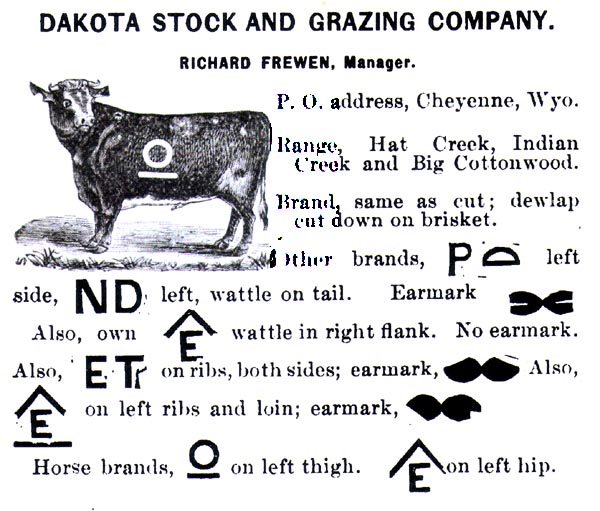
Brands of Richard Frewen's Dakota Stock and Grazing Company, the "Circle Bar."
As indicated on the previous page, Richard Frewen sold to his brother his interest in
Powder River Cattle Company and established his own Dakota Stock and Grazing Company located west of present-day Chadron, Nebraska. At the time, the Sand Hills of
Nebraska were practically empty and Richard's ranch was one of the first in the area.
Before coming to Wyoming and Nebraska,
Dick Frewen had been a widely recognized world traveller, having visited Africa, Russia, India, Japan, and the Dutch East Indies. At the time of the 1884 Rounduup,
Richard Frewen's "Circle Bar" had 30,000 head.
Richard Frewen had escaped total disaster by selling to Moreton his shares in Powder River before the roof fell in.
In 1884, Richard had insufficient funds to return to the United Kingdom for the winter.
Three hundred of his horses were sold in Livingston, Montana, at
Sheriff's Sale. The proceeds failed to fully satisfy the mortgage. But Richard had not learned his lesson on
trusting his brother. In 1886 Dakota Stock and Grazing went into liquidation. From the proceeds pf the liquidation,
shareholders were to receive $5.00 a share.
Richard had loaned Moreton his shares. Moreton promised that they were to be returned when needed. Moreton, however had used the
shares as security for his own debts and, thus, could not return them when needed. In 1888, 426 head of cattle shipped to Chicago were levied upon.
Although Dakota Stock and Grazing did not survive, the brand continued in
Western Nebraska.
Upon his father's death,
Richard had inherited a hunting Lodge and the associated village of Innishannon in Ireland.
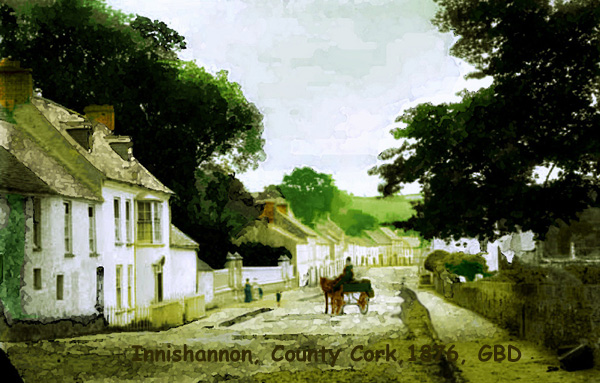
Innishannon, County Cork, 1876, digital water color by Geoff Dobson based on a photograph.
Innishannon provided an income. Additionally Richard inherited £16,000..
Richard Frewen was a fellow of the Royal Geographic Society. Before coming to Wyoming had spent three years, 1876-1878, exploring parts of Cape Colony and what later were to become Northern and Southern
Rhodesia.
During the course of his travels he met the Lobengula, King of the Northern
Ndebele. The King was described as being a bit obese and his royal robes somewhat lacking. Exploration of Ndeble required the King's
permission which was difficult to obtain. After permission from the King was obtained, gifts and proper respect had to be paid to local chiefs.
The meeting with Lobengula was described by
Andrew A. Anderson, "Twenty-five Years in a Waggon in the Gold Regions of Africa," Volume 2
: 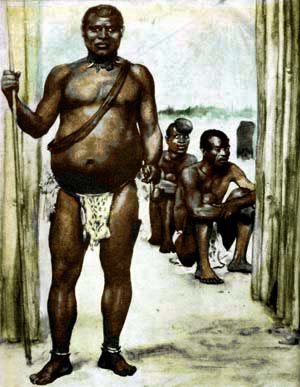 Lobengula, King of the
Northern Ndebolo
Early on Monday morning, Mr. Phillips, old John Viljuen, and Mr. Frewen rode over.
The latter was going further in, and had proceeded some distance,
when he was obliged to turn and come on to this station, and left
this morning on his way down country, my two guards returning to
Makobis with him.
Height of this station by aneroid barometer, 4970 feet above sea-level.
The country round is well wooded, but the trees are small. 20° 25' S. lat., 28° 35' E. long.
I went to call on Lo-Bengulu; he was sitting on his waggon-box naked, all but his cat-tail kilt.
After shaking hands and passing the compliments of the day, I told him, as he expected
one of his regiments over to escort him to the military kraal, I would
defer my talk with him until after the grand dance. He asked me to follow
him when he started; that meant, I was to fall in with the other waggons
of the white people composing the cavalcade.
We started about 11 a.m., Mr. Sykes taking the lead behind the king's
waggons, which were surrounded by about twenty Zulu women and girls.
One waggon held his sister Nina and the Kaffre beer, next followed
Mr. Coillard and his waggons, then my waggon, Phillips, Viljuen, and
other white men on horseback, and about a hundred of the king's bodyguard,
about as unique a turn-out as one could desire to see—an African king on
his travels—it would have graced Regent street.
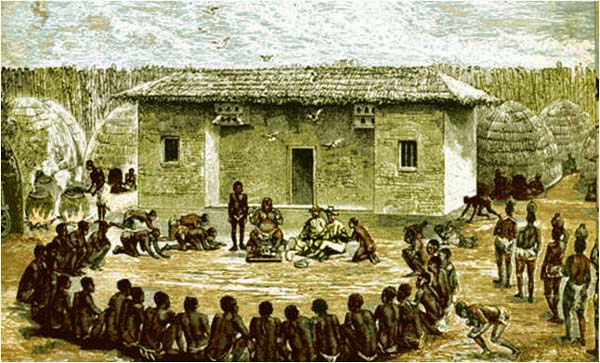
Meeting of Andrew A. Anderson with Lobengula at the King's Military Kraal.
On his journey, Richard carried with him some eight tons of equipment and trading goods. The equipment including and early ice machine and
photographic gear. The photographic gear failed to work. Natives and his bearers stole trading goods, livestock, and money.
Also taken were 60 bottles of brandy.
Apparently, Richard failed to pay proper respect to one of the chiefs, the King's brother,
and his departure was delayed for about a week. To get his way, he threatened to have British troops
to come in an straighten matters out. His companions were held to insure Frewen's behavior.
See, "The narrative of Frederick Hugh Barber and the journal of Richard Frewen. Zambezia and Matabeleland in the Seventies," Chatto &. Windus: London.
Richard wrote two letters of complaint to British authorities in Cape Colony who sent two emmisaries in to
Matabelaland. They were killed.
As souveniers Richard brought back with him to Ireland
some mummified human heads which were discovered following his death. After some suitable
prayers, the heads were buried in the estate's garden.
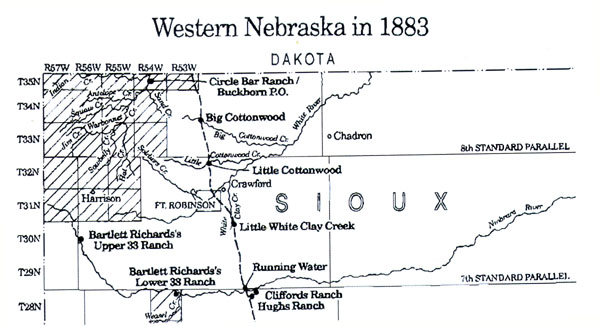
Map showing location of Richard Frewen's "Circle Bar", 1883.
The shaded area in the upper left corner of map is an area that was first surveyed in 1883. The Buckhorn Post Office was allegedly the first post office on
Hat Creek. Barlett Richards' Upper
and Lower 33 Ranch, became the foundation
for the Nebraska Land and Feeding Company, a Wyoming corporation organized in 1898 by
merger of Richards and Cairnes, Inc., and Richards and Comstock. The Nebraska Land and Feeding Company', "Spade Ranch" ultimately became one the largest
ranches in Nebraska and Bartlett Richards one of the wealthiest cattle barons in the United States.
Following liquidation of the Circle Bar and his return from China, Richard Frewen returned to Innishannon.
In September 1890, Richard became betrothed to
Grace January of St. Louis. Mrs. January was the widow of Jesse January, who had made a fortune from silver
mining near Philipsburg, Montana. Mrs. January was reputed to have a fortune of about
$5,000,000. Frewen's solicitors and Mrs. January's lawyer began negotiation of the prenuptual agreement. Unfortunately it was discovered
that Jesse had left the fortune to his widow for her life but only if she did not remarry.
Upon her remarriage, however, the
estate went to Jesse's daughter. The engagement ended. On March 21, 1891, Richard found another widow, Katherine Maria Affleck Wollaston,
the daughter of Sir Richard Affleck and the widow of Lt. Col. Charles Wollaston, late of the 8th Bengal Light Cavalry. Maria died less than four years
later on January 26, 1895 in Montreux, Switzerland.
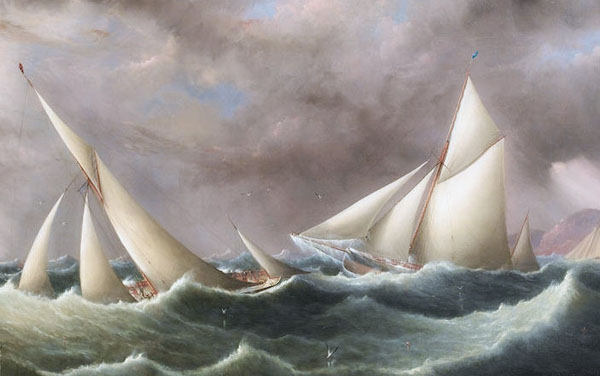
Race between the Latona and the Florinda off St. Catherine's Point, Isle of Wight, August 1881. Painting by
Arthur Wellington Fowles
Richard Frewen became a noted yachtsman and acquired the Yacht Florinda. The Florinda was constructed in 1873 by Camper and Nicholsons of Gosport noted for the longevity of their
vessels. The Florinda, as a result of her speed, was sometimes referred to as the "Gosport Mistake." The Florinda was broken up in 1948 at Weymouth.
On the night of August 17, 1896, Dick Frewen was yachting in the Yacht Florinda. Off the coast of Pembrook,
14 miles southwest of St. Anne's light, the yacht's boat came loose. In attempting to secure it, Richard lost his footing and was swept away
by a large wave. In the darkness he could not be
located and presumably drowned.
Although an advertisement placed in the South Wales News offered a £50 reward for recovery of his body,
his body was never recovered. There is a memorial plaque at St. Mary's Northian, Sussex, where his ancestors were interred.
How should Richard's life be summed up? The best sumation that the writer has found was from
the Saturday Review, 29 August 1896, p. 208:
AD MEMORIAM.
THE death of Mr. Richard Frewen of Innishannon, briefly noticed in the Press of this week, brings to its close a life of more than ordinary interest. In 1873 Mr. Frewen, at that time hardly more than a boy, and unattended by any European, passed through Ladak from the Kashmir side and penetrated Chinese Tartary. Three years later he was at Buluwayo for several weeks, where he had a somewhat risky altercation with Lobengula, whom he accused, with good reason, of encouraging his carriers to desert him. Having visited, during the same year, the Victoria Falls of the Zambesi, on his return the youthful explorer read a paper before the Geographical Society.
Men's memories as to the history of the Transvaal are short, and the following extract from a letter written by Mr. Frewen to a friend last February will be read
with interest at the present time. "It is curious," he writes,
"by the light of recent events, the view 'made in Germany' that England
is anxious to oppress the Dutch element in South Africa. It seems but
the other day that I was at Pretoria, when Sir Theophilus Shepstone,
attended by only thirty mounted police, hoisted the Union Jack over the
Court House, the entire town being thronged by armed Boers, all in
the greatest good humour with us. The Transvaal State was at that
time practically bankrupt; its paper-money at a ruinous discount;
its credit with the Cape banks exhausted. Eighteen months later,
on my return from the Zambesi, I again passed through; the State
credit had in that short interval been restored; its revenue was
adequate, and the money value of the Boer farms had at least doubled
during my absence in the north. Cetewayo, the Zulu king, said to me, '
I would that you English would stay south for six months, just
while I clear my country of these Dutchmen.' This episode of a British
occupation urgently invited by the Boers, and of its golden results,
seems to have made no impression upon the reptile Press in Germany; but
rely on it, Uncle Paul recalls the cash value of our intervention and
occupation at a time when he was in great straits, and in his heart
of hearts he is not ungrateful."
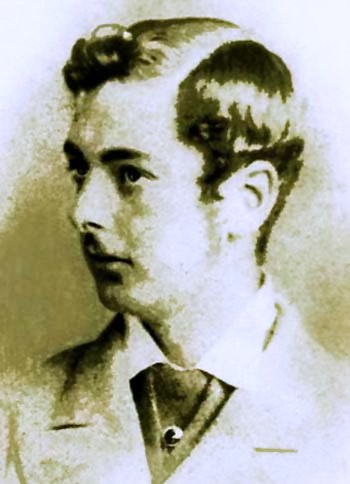
Richard Frewen as a young man
An incorrigible rolling stone, Mr. Frewen was next a pioneer in the
disastrous ranching exodus of Young England to West America.
Settling for a brief period in the Big Horn Mountains, shortly after
the massacre of General Custer by the Sioux on the Little Horn River,
he entertained in 1880 the late Sir Samuel Baker, who devotes
a chapter of his book on "Big Game " to the sport he secured under his host's auspices. A later expedition still was
to the upper waters of the Yukon River, in Alaska—a country which
Mr. Frewen always declared would some day start a gold-mining " boom"
to eclipse even that in South Africa.
The tragedy, which leaves the volume of a strange history
with the pages but half cut, will recall over half the earth's
surface memories of a good sportsman and traveller. The end came
without a moment's warning. Mr. Frewen was a working yachtsman
of many years' experience, and when helping to stow a boat which
had swung loose, in half a gale and toward midnight, off the Welsh
coast, he missed his footing, and was instantly swept overboard, with
a whole ship's crew almost within arm's length of their hapless employer.
[Writer's Note: The hoisting of the flag over the court house by Sir Theophilus Sheptone, April 12, 1877, presaged the First Boer
War, 1880-1881.]
Although Dick Frewen's stay in Wyoming was but brief, to him may be attributed the success of ranching in the sandills
of Western Nebraska and Eastern Central Wyoming. Credit is usually
given to Bartlett Richards, but Dick Frewen's purchase and operation of the Hat Ranch preceded
Bartlett Richards' Spade Ranch. Dick Frewen was a founding member of the Cheyenne Club.
Next Page, Moreton Frewen continued, Hyderabad, Australia.
|